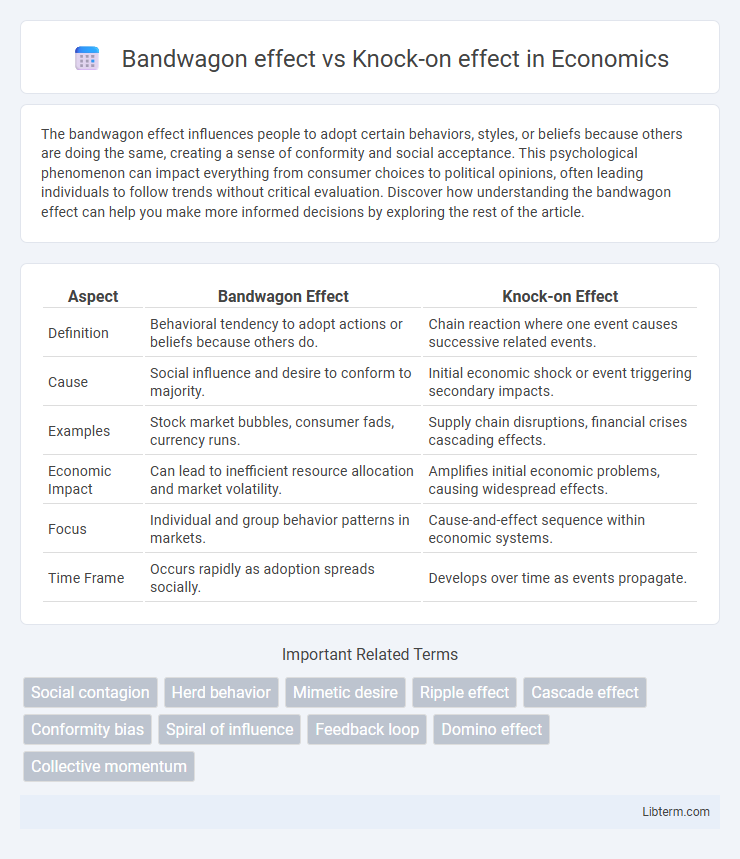The bandwagon effect influences people to adopt certain behaviors, styles, or beliefs because others are doing the same, creating a sense of conformity and social acceptance. This psychological phenomenon can impact everything from consumer choices to political opinions, often leading individuals to follow trends without critical evaluation. Discover how understanding the bandwagon effect can help you make more informed decisions by exploring the rest of the article.
Table of Comparison
| Aspect | Bandwagon Effect | Knock-on Effect |
|---|---|---|
| Definition | Behavioral tendency to adopt actions or beliefs because others do. | Chain reaction where one event causes successive related events. |
| Cause | Social influence and desire to conform to majority. | Initial economic shock or event triggering secondary impacts. |
| Examples | Stock market bubbles, consumer fads, currency runs. | Supply chain disruptions, financial crises cascading effects. |
| Economic Impact | Can lead to inefficient resource allocation and market volatility. | Amplifies initial economic problems, causing widespread effects. |
| Focus | Individual and group behavior patterns in markets. | Cause-and-effect sequence within economic systems. |
| Time Frame | Occurs rapidly as adoption spreads socially. | Develops over time as events propagate. |
Understanding the Bandwagon Effect
The Bandwagon Effect describes the psychological phenomenon where individuals adopt behaviors, styles, or attitudes primarily because others are doing so, leading to rapid social conformity and widespread trends. This effect significantly influences consumer behavior, political movements, and social media dynamics by creating momentum that can amplify popularity independently of intrinsic value. Understanding the Bandwagon Effect helps explain how collective behavior often overrides individual preferences, driving herd mentality in markets and group decisions.
What is the Knock-on Effect?
The knock-on effect refers to a chain reaction where one event triggers a series of related consequences across different areas or sectors. Often seen in economics or social behaviors, a small change or disruption in one place can lead to significant and widespread impacts elsewhere. Understanding the knock-on effect helps predict how initial actions or incidents ripple through complex systems.
Core Differences Between Bandwagon and Knock-on Effects
The Bandwagon effect describes a psychological phenomenon where individuals adopt behaviors or opinions primarily because others are doing so, driven by social influence and herd mentality. In contrast, the Knock-on effect refers to a chain reaction where one event triggers a series of subsequent events or consequences, emphasizing causality and sequential impact. The core difference lies in the Bandwagon effect's focus on social conformity, while the Knock-on effect centers on the propagation of outcomes across interconnected events.
Psychological Underpinnings of the Bandwagon Effect
The Bandwagon effect is rooted in social conformity and the human desire for acceptance, where individuals adopt beliefs or behaviors primarily because others do. Psychological mechanisms such as normative social influence and herd behavior drive this phenomenon, reinforcing group cohesion and reducing uncertainty in decision-making. In contrast, the Knock-on effect involves a series of consequential impacts triggered by an initial action, emphasizing causality rather than social acceptance.
The Mechanisms Behind Knock-on Effects
Knock-on effects occur when an initial event triggers a chain reaction, impacting multiple related systems or sectors through interconnected dependencies. This mechanism relies on causal links where changes in one area create subsequent impacts elsewhere, often magnifying the original event's consequences. Understanding supply chain fragility and network interdependencies is crucial to predicting and managing knock-on effects effectively.
Bandwagon Effect in Social Media and Consumer Behavior
The Bandwagon Effect in social media drives consumer behavior by amplifying trends through widespread adoption as users mimic popular choices to gain social validation. This phenomenon leverages social proof, where increased engagement and visibility create a feedback loop, boosting product demand and influencer credibility. Brands capitalize on this effect by strategically fostering viral content and influencer endorsements to accelerate market penetration and consumer loyalty.
Real-world Examples of Knock-on Effects
The knock-on effect, evident in real-world scenarios such as supply chain disruptions during the COVID-19 pandemic, occurs when a single event triggers a cascade of related impacts across various industries, leading to delays and shortages globally. For example, the semiconductor shortage caused knock-on effects in the automotive industry, forcing factories to halt production and affecting vehicle availability. Unlike the bandwagon effect, which relies on social influence and collective behavior, knock-on effects emphasize direct, tangible consequences stemming from initial disruptions or changes.
Impacts on Decision Making: Bandwagon vs Knock-on
The Bandwagon effect influences decision-making by causing individuals to adopt beliefs or behaviors primarily because others are doing so, often leading to herd mentality and reduced critical thinking. In contrast, the Knock-on effect triggers a chain reaction where one decision or event sets off a series of subsequent decisions or outcomes, amplifying the initial impact through interconnected consequences. Both effects shape decision-making processes but differ in that the Bandwagon effect emphasizes social conformity, while the Knock-on effect highlights cascading results from a single action.
Mitigating Negative Consequences of Both Effects
Mitigating negative consequences of the bandwagon effect and knock-on effect involves enhancing critical thinking and promoting awareness of cognitive biases in decision-making processes. Implementing structured feedback mechanisms and encouraging independent verification can reduce irrational herd behavior and prevent cascading failures. Organizations should also design robust contingency plans and communication strategies to manage ripple effects efficiently, minimizing systemic risks.
Summary: Choosing Awareness Over Influence
The Bandwagon effect describes individuals adopting behaviors or beliefs primarily because others do, highlighting the power of social influence. The Knock-on effect involves a chain reaction where one event causes subsequent consequences, emphasizing causality rather than conformity. Choosing awareness over influence means recognizing these effects to make informed decisions rather than being swayed by social pressure or unintended outcomes.
Bandwagon effect Infographic

 libterm.com
libterm.com